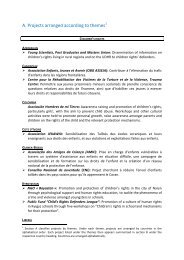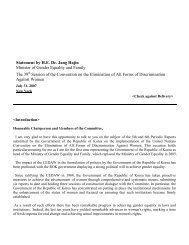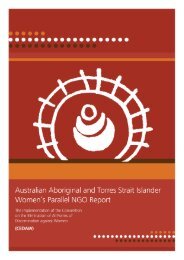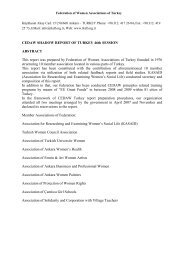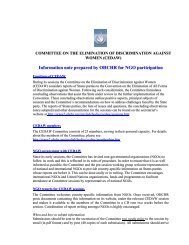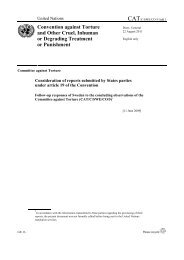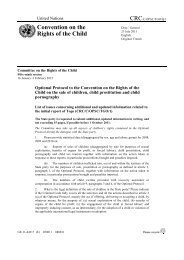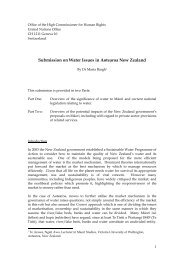Report - Office of the High Commissioner on Human Rights
Report - Office of the High Commissioner on Human Rights
Report - Office of the High Commissioner on Human Rights
- No tags were found...
Create successful ePaper yourself
Turn your PDF publications into a flip-book with our unique Google optimized e-Paper software.
4<br />
Regi<strong>on</strong>al Trends and Patterns in Pacific<br />
Women’s <strong>Rights</strong> to Land and Housing<br />
Based <strong>on</strong> <str<strong>on</strong>g>the</str<strong>on</strong>g> testim<strong>on</strong>ies and related discussi<strong>on</strong>s <strong>on</strong> <str<strong>on</strong>g>the</str<strong>on</strong>g> methodology, key c<strong>on</strong>cepts relevant to realising<br />
women’s right to adequate housing were identified and related to women’s experiences in <str<strong>on</strong>g>the</str<strong>on</strong>g> Pacific<br />
in order to develop a comm<strong>on</strong> regi<strong>on</strong>al picture <str<strong>on</strong>g>of</str<strong>on</strong>g> women’s housing and land issues in <str<strong>on</strong>g>the</str<strong>on</strong>g> regi<strong>on</strong>.<br />
Lack <str<strong>on</strong>g>of</str<strong>on</strong>g> women’s participati<strong>on</strong> in decisi<strong>on</strong>-making at all levels<br />
Women are not included in all levels <str<strong>on</strong>g>of</str<strong>on</strong>g> decisi<strong>on</strong>-making processes related to adequate housing and<br />
land. This is reinforced by traditi<strong>on</strong>al and religious practices and norms that give supremacy to male<br />
power and <str<strong>on</strong>g>the</str<strong>on</strong>g>refore omit women from decisi<strong>on</strong>-making forums. As a result, women are absent from<br />
<str<strong>on</strong>g>the</str<strong>on</strong>g> processes where government policies <strong>on</strong> land and housing are developed. Decisi<strong>on</strong>-making in <str<strong>on</strong>g>the</str<strong>on</strong>g><br />
clan is dominated by men folk. At <str<strong>on</strong>g>the</str<strong>on</strong>g> family level as well women are not involved in decisi<strong>on</strong>s pertaining<br />
to land and housing, particularly if <str<strong>on</strong>g>the</str<strong>on</strong>g>y do not have a s<strong>on</strong> who has a right to inheritance. The exclusi<strong>on</strong><br />
<str<strong>on</strong>g>of</str<strong>on</strong>g> women from decisi<strong>on</strong>-making processes is largely due to a lack <str<strong>on</strong>g>of</str<strong>on</strong>g> understanding as well as an<br />
underestimati<strong>on</strong> <str<strong>on</strong>g>of</str<strong>on</strong>g> a woman’s capacity . The family unit is an important arena for women to participate<br />
in because such decisi<strong>on</strong>s have a direct impact <strong>on</strong> <str<strong>on</strong>g>the</str<strong>on</strong>g>m; this is <str<strong>on</strong>g>the</str<strong>on</strong>g>refore an important level at which<br />
to encourage women’s participati<strong>on</strong> in decisi<strong>on</strong>-making.<br />
Patriarchal cultures<br />
Patriarchal systems <str<strong>on</strong>g>of</str<strong>on</strong>g> discriminati<strong>on</strong> against women are reflected in customary practices and religious<br />
beliefs. These are reinforced in <str<strong>on</strong>g>the</str<strong>on</strong>g> family and community, and <str<strong>on</strong>g>of</str<strong>on</strong>g>ten use violence against women to<br />
reinforce gendered systems <str<strong>on</strong>g>of</str<strong>on</strong>g> power. Inheritance laws are <strong>on</strong>e manifestati<strong>on</strong> <str<strong>on</strong>g>of</str<strong>on</strong>g> patriarchy that<br />
particularly affects women’s rights to housing and land. The lack <str<strong>on</strong>g>of</str<strong>on</strong>g> awareness am<strong>on</strong>g women <str<strong>on</strong>g>of</str<strong>on</strong>g> <str<strong>on</strong>g>the</str<strong>on</strong>g>ir<br />
rights to equality and n<strong>on</strong>-discriminati<strong>on</strong> limits <str<strong>on</strong>g>the</str<strong>on</strong>g> possibilities for challenging patriarchal cultures.<br />
Intersecti<strong>on</strong>al<br />
discriminati<strong>on</strong><br />
An intersecti<strong>on</strong>al approach is necessary to address violati<strong>on</strong>s <str<strong>on</strong>g>of</str<strong>on</strong>g> women’s rights where women are<br />
experiencing compounding discriminati<strong>on</strong>, including <strong>on</strong> <str<strong>on</strong>g>the</str<strong>on</strong>g> grounds <str<strong>on</strong>g>of</str<strong>on</strong>g> sexual orientati<strong>on</strong>, disability,<br />
ethnicity/race (including <str<strong>on</strong>g>the</str<strong>on</strong>g> persistence <str<strong>on</strong>g>of</str<strong>on</strong>g> racism from col<strong>on</strong>ialism times) and <str<strong>on</strong>g>the</str<strong>on</strong>g> multiple<br />
discriminati<strong>on</strong> faced by indigenous women.<br />
EXECUTIVE SUMMARY 47




